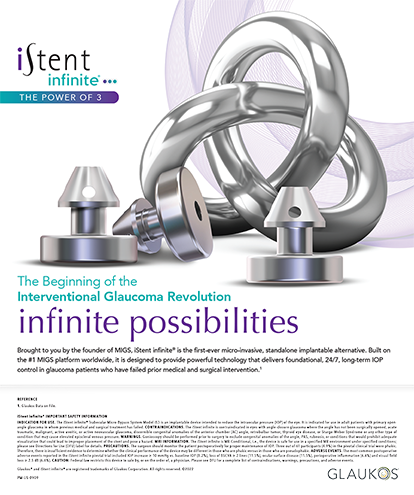

Endophthalmitis Reduction With Intracameral Moxifloxacin Prophylaxis: an Analysis of 600,000 Surgeries
Haripriya A, Chang DF, Ravindran RD1

ABSTRACT SUMMARY
Haripriya and colleagues performed a large retrospective clinical registry review of the rate of endophthalmitis after cataract extraction before and after the initiation of intracameral (IC) moxifloxacin. The researchers reviewed 617,453 cases performed at 10 Aravind Eye Hospitals between January 2014 and May 2016. Furthermore, they performed subgroup analysis on patients with posterior capsular rupture (PCR).
Patients were monitored on postoperative day 1 and at postoperative month 1. The primary outcome measured was postoperative endophthalmitis rates. Surgeries were phacoemulsification (194,252 cases), manual small-incision cataract surgery (M-SICS; 414,657 cases), or manual large-incision extracapsular cataract extraction (8,544 cases).
AT A GLANCE
- Investigators conducted a large retrospective clinical registry review of the rate of endophthalmitis after cataract extraction before and after the initiation of intracameral moxifloxacin at 10 Aravind Eye Hospitals. They found that this method of prophylaxis was associated with lower rates of endophthalmitis, particularly in high-risk cases like posterior capsular rupture.
- A major study outlined diagnostic criteria for vancomycin-associated hemorrhagic occlusive retinal vasculitis.
Of 302,815 eyes not receiving IC moxifloxacin, 214 (0.07%) developed endophthalmitis, and of 314,638 receiving IC moxifloxacin, 64 (0.02%) developed endophthalmitis (P < .001). In the eyes that underwent phacoemulsification, the rate of endophthalmitis was significantly higher (P < .001) in cases without IC moxifloxacin (75/104,894 or 0.07%) than in those with IC moxifloxacin (11/89,358 or 0.01%). Of 8,479 cases with PCR, 20 of 4,186 (0.48%) not treated with IC moxifloxacin developed endophthalmitis compared with nine of 4,293 (0.21%) that received the prophylaxis (P = .034).
Overall, the investigators found a 3.5-fold reduction in endophthalmitis rates in those treated with IC moxifloxacin compared to those who were not. The researchers concluded that IC antibiotic prophylaxis should be considered, particularly for high-risk eyes like those involving PCR with vitreous loss.
DISCUSSION
Given the devastating effect endophthalmitis can have on patients after cataract extraction, minimizing this sequela is of particular interest to surgeons. The use of IC antibiotic prophylaxis, particularly cefuroxime, has been increasing since its effectiveness was suggested in multiple studies.2-4 Unfortunately, IC cefuroxime is largely unavailable outside of Europe, and although IC vancomycin and moxifloxacin are used, there are few studies regarding their efficacy. Given evidence suggesting an association of vancomycin and hemorrhagic occlusive retinal vasculitis (HORV),5 consideration of IC moxifloxacin is growing.
The research by Haripriya and colleagues is one of the largest retrospective studies evaluating the use of IC moxifloxacin, and it found a 3.5-fold reduction in overall endophthalmitis rates. In particular, the investigators found a sixfold reduction in the rate of endophthalmitis in cases using phacoemulsification and a threefold reduction in cases involving M-SICS, with no increase in adverse events in the group using IC moxifloxacin. Other studies evaluating the safety profile of IC moxifloxacin have reached similar conclusions.6,7 Finally, the rate of PCR, a risk factor for endophthalmitis,8 was found to be no different among the groups, but the rate of endophthalmitis was found to be lower in the group using IC prophylaxis.
The research by Haripriya and colleagues is notable for minimizing confounding variables by selecting hospitals with a high degree of standardization in terms of protocol and minimizing surgeon turnover with a short study time period (29 months). In conclusion, the investigators found that the use of IC moxifloxacin was associated with lower rates of endophthalmitis, particularly in high-risk cases like PCR.
Vancomycin-Associated Hemorrhagic Occlusive Retinal Vasculitis: Clinical Characteristics of 36 Eyes
Witkin AJ, Chang DF, Jumper JM, et al5
ABSTRACT SUMMARY
Witkin and colleagues sought to better understand vancomycin-associated HORV. They performed a retrospective case series of 36 eyes from 23 patients with HORV. Cases were obtained through an online registry on the American Society of Cataract and Refractive Surgery’s and American Society of Retina Specialists’ websites and surveys emailed to members of both societies. Of 36 eyes, 33 received IC bolus doses of vancomycin, one received an intravitreal injection, and two received vancomycin via irrigation bottle.
On average, patients sought treatment 8 days (range, 1-21 days) after surgery. Twenty-two of 36 eyes (61%) had a visual acuity of 20/200 or worse, and eight of 36 (22%) had no light perception. Neovascular glaucoma developed in 20 of 36 eyes (56%). Seven eyes were treated with additional intravitreal vancomycin; five of these ended up with no-light-perception vision, and all developed 20/400 or worse visual acuity. Three eyes received intravitreal steroids and had visual acuities of 20/40, 20/70, and hand motion.
The investigators identified seven characteristic findings, outlined in the sidebar. They also noted optical coherence tomography findings demonstrating hyperreflectivity and thickening of the inner retinal layers. They concluded that there is a rare association between vancomycin and HORV and that these patients should be monitored closely to prevent sequela.
DISCUSSION
The use of IC antibiotics during cataract extraction increased in the United States from 30% in 2007 to 50% in 2014, as noted by surveys of members of the American Society of Cataract and Refractive Surgery.9,10 Because cefuroxime is not available commercially in the United States and because of vancomycin’s safety, availability, coverage, and efficacy, the latter was administered by about 52% of US surgeons using IC antibiotics.11
WITKIN AND COLLEAGUES IDENTIFIED SEVEN CHARACTERISTIC FINDINGS:
1. HORV presents after an intraocular procedure with normal nondilated examination on postoperative day 1.
2. The onset is delayed. The decrease in vision is sudden and painless.
3. Patients’ visual acuity is typically poor at presentation but may be normal in mild cases.
4. There is mild to moderate anterior chamber and vitreous inflammation without hypopyon.
5. There are sectoral intraretinal hemorrhages in areas of nonperfusion, typically along venules.
6. The peripheral retina is involved, with macular involvement in severe cases.
7. Fluorescein angiography shows retinal vasculitis and vascular occlusion correlating to hemorrhage areas.
Witkin and colleagues found a rare association between vancomycin and HORV. This is the first major study to outline diagnostic criteria for vancomycin-associated HORV. The researchers reported that the differential diagnosis includes central retinal vein occlusion, postoperative endophthalmitis, toxic anterior segment syndrome, and viral retinitis. It is important to distinguish HORV from postoperative endophthalmitis, given the study’s finding that further injection of vancomycin was associated with worse visual outcomes. The investigators noted that patients with endophthalmitis typically present with greater pain and a more vigorous inflammatory reaction, oftentimes including a hypopyon. Witkin and colleagues speculated that the mechanism is likely a type III hypersensitivity reaction. This is important because the researchers noted that visual outcomes were better in the three eyes treated with corticosteroids, suggesting a possible treatment option.
The identification of vancomycin-associated HORV is important, given the high association with neovascular glaucoma. There may be a role for treatment with antivascular endothelial growth factor or panretinal photocoagulation to minimize this devastating sequela.
1. Haripriya A, Chang DF, Ravindran RD. Endophthalmitis reduction with intracameral moxifloxacin prophylaxis. Ophthalmology. 2017;124(6):768-775.
2. Endophthalmitis Study Group, European Society of Cataract & Refractive Surgeons. Prophylaxis of postoperative endophthalmitis following cataract surgery: results of the ESCRS multicenter study and identification of risk factors. J Cataract Refract Surg. 2007;33(6):978-988.
3. Jabbarvand M, Hashemian H, Khodaparast M, et al. Endophthalmitis occurring after cataract surgery: outcomes of more than 480 000 cataract surgeries, epidemiologic features, and risk factors. Ophthalmology. 2016;123(2):295-301.
4. Daien V, Papinaud L, Gillies MC, et al. Effectiveness and safety of an intracameral injection of cefuroxime for the prevention of endophthalmitis after cataract surgery with or without perioperative capsular rupture. JAMA Ophthalmol. 2016;134(7):810-816.
5. Witkin AJ, Chang DF, Jumper JM, et al. Vancomycin-associated hemorrhagic occlusive retinal vasculitis. Ophthalmology. 2017;124(5):583-595.
6. Lane SS, Osher RH, Masket S, Belani S. Evaluation of the safety of prophylactic intracameral moxifloxacin in cataract surgery. J Cataract Refract Surg. 2008;34(9):1451-1459.
7. Ekinci Koktekir B, Aslan BS. Safety of prophylactic intracameral moxifloxacin use in cataract surgery. J Ocul Pharmacol Ther. 2012;28(3):278-282.
8. Cao H, Zhang L, Li L, Lo S. Risk factors for acute endophthalmitis following cataract surgery: a systematic review and meta-analysis. PLoS One. 2013;8(8):e71731.
9. Chang DF, Braga-Mele R, Henderson BA, et al; ASCRS Cataract Clinical Committee. Antibiotic prophylaxis of postoperative endophthalmitis after cataract surgery: results of the 2014 ASCRS member survey. J Cataract Refract Surg. 2015;41(6):1300-1305.
10. Chang DF, Braga-Mele R, Mamalis N, et al; ASCRS Cataract Clinical Committee. Prophylaxis of postoperative endophthalmitis after cataract surgery: results of the 2007 ASCRS member survey. J Cataract Refract Surg. 2007;33(10):1801-1805.
11. Braga-Mele R, Chang DF, Henderson BA, et al; ASCRS Cataract Clinical Committee. Intracameral antibiotics: safety, efficacy, and preparation. J Cataract Refract Surg. 2014;40(12):2134-2142.




